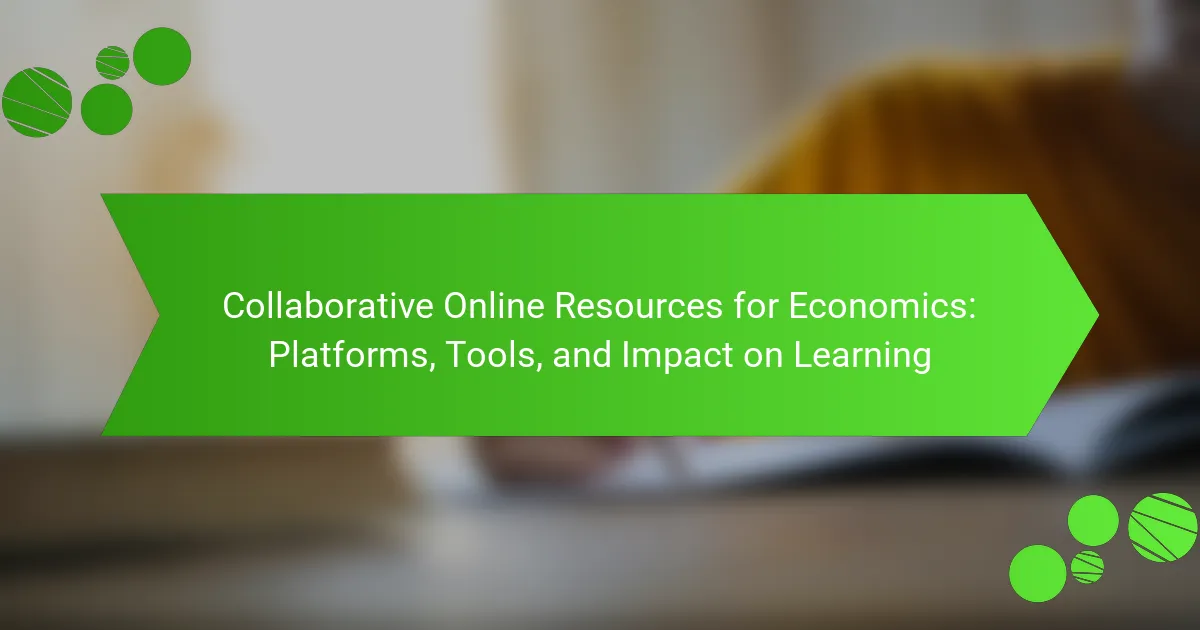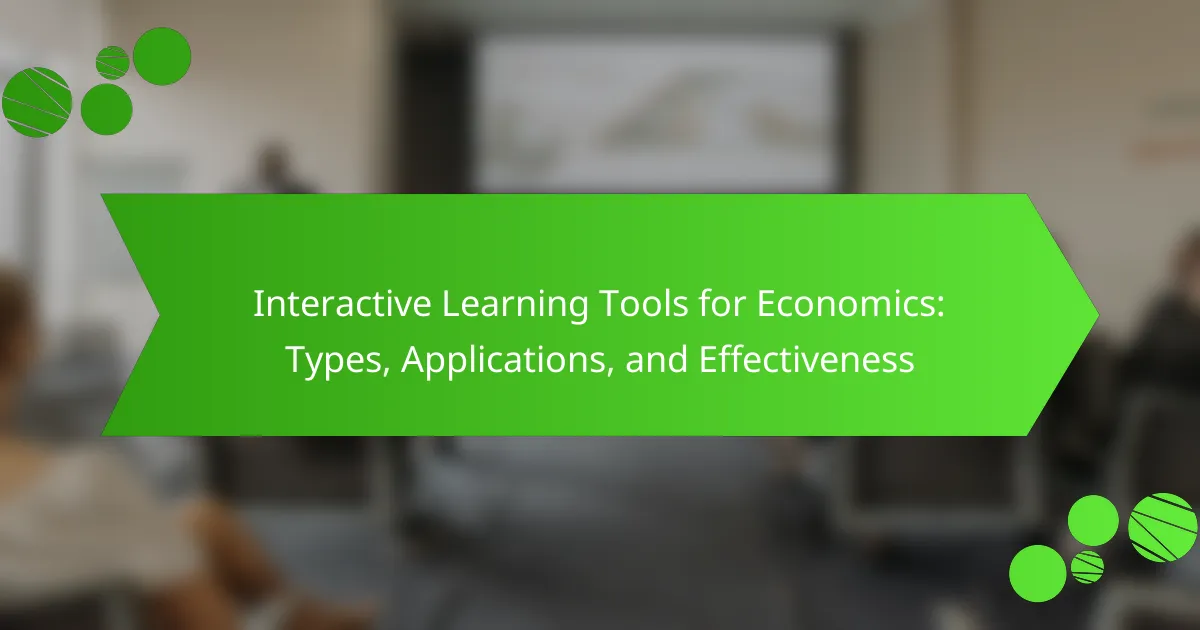E-books and digital textbooks for economics are electronic resources designed to facilitate the study of economic concepts, theories, case studies, and data analysis. These digital formats offer interactive features such as hyperlinks, multimedia elements, and search capabilities, making them accessible across various devices including tablets, laptops, and smartphones. Common formats include PDF, EPUB, MOBI, and HTML, each catering to different reading preferences and device compatibility. Research highlights that students using these digital resources experience improved retention and engagement. Future trends indicate a move towards increased interactivity, personalization, and the integration of technologies like AI and blockchain, enhancing the overall educational experience in economics.
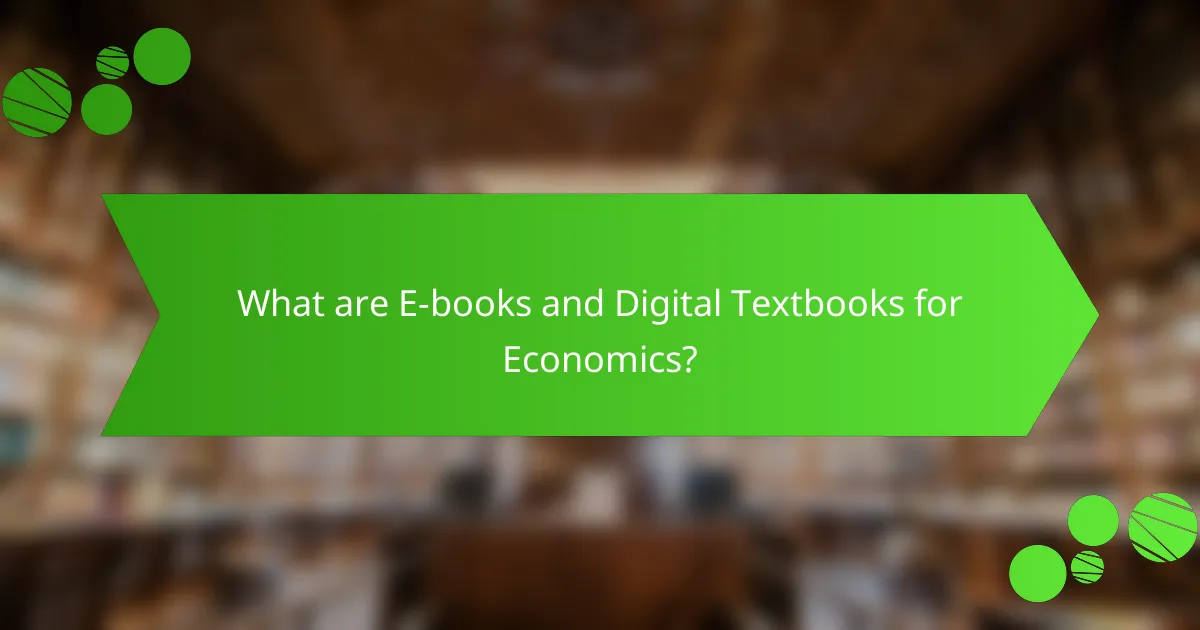
What are E-books and Digital Textbooks for Economics?
E-books and digital textbooks for economics are electronic versions of traditional books used for studying economic concepts. They provide a range of content including theories, case studies, and data analysis. These resources are often interactive, featuring hyperlinks, multimedia, and search functions. E-books are accessible on various devices such as tablets, laptops, and smartphones. Digital textbooks typically align with academic curricula and may include additional features like quizzes and assessments. Research indicates that students using digital formats can improve retention and engagement. A study by the National Center for Education Statistics found that 20% of college students used e-books in their courses as of 2019.
How do E-books and Digital Textbooks differ from traditional textbooks?
E-books and digital textbooks differ from traditional textbooks primarily in their format and accessibility. E-books are digital versions of books that can be read on electronic devices. Digital textbooks are specifically designed for educational purposes and often include interactive features. Traditional textbooks are physical books made of paper and ink.
E-books and digital textbooks can be updated easily, ensuring that content remains current. In contrast, traditional textbooks require reprinting for updates. E-books and digital textbooks often come with multimedia elements, such as videos and quizzes, enhancing the learning experience. Traditional textbooks lack these interactive features.
Furthermore, e-books and digital textbooks are typically more portable. They can be accessed on various devices, allowing for learning on-the-go. Traditional textbooks are bulkier and less convenient to carry. According to a study by the National Center for Education Statistics, digital learning materials can improve student engagement and performance. This highlights the advantages of e-books and digital textbooks over traditional formats.
What are the key features of E-books and Digital Textbooks?
E-books and digital textbooks offer several key features that enhance learning. They provide interactive content, such as quizzes and videos, which engage students more effectively. Accessibility is a significant advantage; these resources can be accessed on various devices anytime. E-books often allow for customizable reading experiences, such as adjustable font sizes and background colors. They typically include search functions, enabling users to find information quickly. Additionally, digital textbooks can be updated easily, ensuring that content remains current. Many platforms offer note-taking and highlighting features, facilitating better study practices. According to a study by the National Center for Education Statistics, digital learning tools improve student engagement and retention rates.
How do formats impact the usability of E-books and Digital Textbooks?
Formats significantly influence the usability of E-books and Digital Textbooks. Different formats, such as PDF, EPUB, and MOBI, offer varying levels of compatibility and features. For instance, EPUB supports reflowable text, enhancing readability on multiple devices. PDF, while widely used, can be less flexible on smaller screens. Usability is also affected by interactive elements available in certain formats. Features like hyperlinks, embedded videos, and quizzes can enhance engagement and learning. Research indicates that formats with enhanced interactivity improve retention rates among students. A study by the University of Washington found that students using interactive E-books scored 20% higher on comprehension tests compared to those using static formats. Therefore, the choice of format directly impacts the overall effectiveness and user experience of E-books and Digital Textbooks.
What are the main advantages of using E-books and Digital Textbooks for Economics?
E-books and digital textbooks for economics offer several advantages. They provide instant access to a wide range of resources. This immediacy enhances research capabilities for students and educators. E-books often include interactive features, such as hyperlinks and multimedia content. These features can enhance understanding of complex economic concepts.
Additionally, digital formats are typically more affordable than printed textbooks. According to a study by the National Association of College Stores, digital textbooks can be up to 60% cheaper. E-books also allow for easy updates, ensuring that content remains current with the latest economic theories and data.
Furthermore, they are portable, enabling users to access materials from multiple devices. This flexibility supports learning in various environments. Many e-books offer search functionality, allowing for quick information retrieval. This can save time during study sessions. Overall, e-books and digital textbooks enhance the learning experience in economics through accessibility, affordability, and interactivity.
How do E-books and Digital Textbooks enhance learning experiences?
E-books and digital textbooks enhance learning experiences by providing interactive and accessible content. They often include multimedia elements like videos and quizzes. This interactivity engages students more effectively than traditional textbooks. E-books can be updated easily, ensuring that learners have the most current information. Digital formats allow for search functions, enabling quick access to specific topics. They are also portable, allowing students to carry multiple resources on a single device. Research indicates that students using digital materials perform better in comprehension tests. A study by the National Education Association found that digital learning tools can increase student engagement by up to 30%.
What cost benefits do E-books and Digital Textbooks provide?
E-books and digital textbooks offer significant cost benefits compared to traditional print versions. They typically have lower purchase prices, often reducing costs by 30% to 50%. This reduction is due to the absence of printing and shipping expenses. Additionally, many digital textbooks provide rental options, allowing students to access materials for a fraction of the purchase price.
E-books can also be updated more frequently, ensuring students have access to the latest information without needing to buy new editions. Furthermore, e-books eliminate the need for physical storage, which can save on costs related to space and materials.
Research indicates that students can save an average of $300 per year by utilizing digital formats instead of traditional textbooks. This financial advantage makes e-books and digital textbooks an appealing choice for budget-conscious students and educational institutions.
How do E-books and Digital Textbooks improve accessibility for students?
E-books and digital textbooks improve accessibility for students by providing flexible formats and features. They allow for adjustable text sizes and background colors, enhancing readability. Many digital texts include audio options, supporting auditory learners. Search functions make locating information easier and faster. Accessibility features like screen readers assist visually impaired students. Digital formats reduce physical weight, making materials easier to carry. E-books can be accessed on various devices, ensuring availability anytime and anywhere. According to a study by the National Center on Accessible Educational Materials, 80% of students reported improved learning experiences with digital resources.
What technologies support accessibility in E-books and Digital Textbooks?
Technologies that support accessibility in E-books and Digital Textbooks include screen readers, text-to-speech software, and adjustable text sizes. Screen readers convert text into speech, allowing visually impaired users to access content. Text-to-speech software reads aloud written text, enhancing comprehension for users with reading disabilities. Adjustable text sizes enable users to customize font size for better readability. Additionally, alternative formats like Braille and audio versions ensure inclusivity. These technologies comply with accessibility standards, such as the Web Content Accessibility Guidelines (WCAG), which promote equal access to digital content.
How can E-books and Digital Textbooks cater to diverse learning needs?
E-books and digital textbooks can cater to diverse learning needs by offering customizable features. These features include adjustable text sizes, background colors, and font styles. Such options enhance readability for individuals with visual impairments or learning disabilities. E-books often provide multimedia elements like videos and interactive quizzes. This engagement supports various learning styles, such as visual and auditory learners. Additionally, digital formats allow for easy note-taking and highlighting. These tools help learners organize and retain information effectively. According to a study by the University of California, students using digital textbooks reported improved comprehension and retention. This evidence supports the effectiveness of e-books in meeting diverse educational requirements.
What challenges do users face with E-books and Digital Textbooks?
Users face several challenges with E-books and Digital Textbooks. One significant issue is eye strain from prolonged screen time. Research indicates that 60% of E-book users experience discomfort after extended reading sessions. Another challenge is the limited battery life of devices, which can disrupt reading sessions. Many users report that their devices last only a few hours on a single charge. Additionally, the navigation of digital formats can be cumbersome. Users often struggle with finding specific content quickly. Compatibility issues with different devices and software also pose a problem. Some E-books may not function properly across all platforms. Lastly, accessibility features can be inadequate. Users with disabilities may find that digital texts do not meet their needs, limiting their ability to engage fully with the material.
How can users overcome technical issues with E-books and Digital Textbooks?
Users can overcome technical issues with E-books and Digital Textbooks by following specific troubleshooting steps. First, they should ensure their device is compatible with the e-book format. Most e-books are in formats like EPUB or PDF, which require specific applications. Next, users can update their e-reader software or app to the latest version. Outdated software often causes compatibility issues.
Additionally, users should check their internet connection. A stable connection is crucial for downloading and accessing content. Clearing the app cache can also resolve performance issues. If the e-book is not opening, users can try re-downloading it. Sometimes, files can become corrupted during the download process.
For further assistance, users can consult the help section of the e-book platform or reach out to customer support. Many platforms provide detailed FAQs and troubleshooting guides. According to a 2022 survey by the Pew Research Center, 45% of e-book users reported encountering technical issues, highlighting the importance of knowing how to address these problems effectively.
What are the limitations of E-books and Digital Textbooks in Economics education?
E-books and digital textbooks in economics education have several limitations. One major limitation is the lack of interactive features compared to traditional textbooks. Many e-books do not offer the same level of engagement through diagrams or exercises. Another limitation is the potential for technical issues. Students may face difficulties such as software malfunctions or compatibility problems with devices.
Additionally, e-books often require internet access, which can be a barrier for some students. This reliance on technology can lead to accessibility issues for those in remote areas. Moreover, the reading experience can be less immersive. Studies show that students retain information better from physical books than from screens.
Furthermore, e-books may not always include the latest information or updates. This can be particularly important in a dynamic field like economics. Lastly, there are concerns about the long-term availability of digital content. Publishers may remove titles or change access policies, leaving students without essential resources.
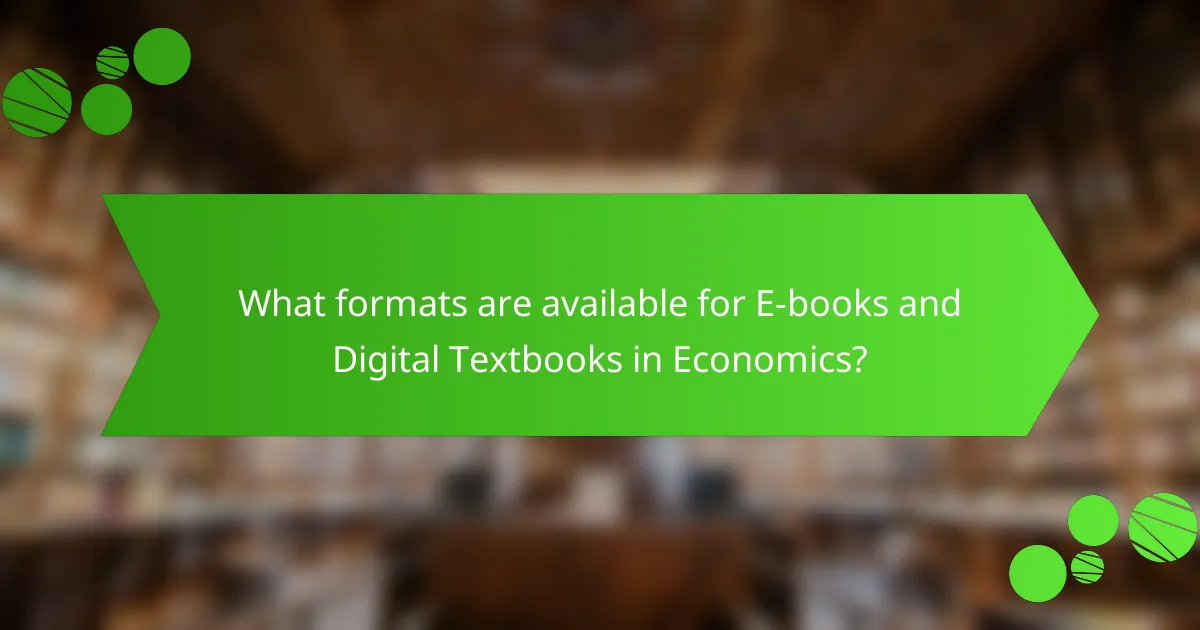
What formats are available for E-books and Digital Textbooks in Economics?
E-books and digital textbooks in economics are available in several formats. Common formats include PDF, EPUB, MOBI, and HTML. PDF is widely used for its fixed layout and compatibility with various devices. EPUB allows for reflowable content, making it adaptable to different screen sizes. MOBI is primarily used for Amazon Kindle devices. HTML format enables online reading through web browsers. Each format has unique features that cater to different reading preferences and devices.
What are the different file formats used for E-books and Digital Textbooks?
The different file formats used for E-books and Digital Textbooks include EPUB, PDF, MOBI, and AZW. EPUB is a widely adopted format that allows for reflowable content. It is compatible with most e-readers and apps. PDF is a fixed-layout format that maintains the original design. It is commonly used for textbooks that require precise formatting. MOBI is a format developed by Amazon for Kindle devices. It supports features like bookmarks and annotations. AZW is another Amazon format, specifically for Kindle, offering advanced features like DRM protection. Each format serves different needs and device compatibilities in the digital reading landscape.
How do PDF, EPUB, and MOBI formats compare for Economics content?
PDF, EPUB, and MOBI formats serve different purposes for Economics content. PDF is widely used for its fixed layout, preserving formatting across devices. This makes it ideal for academic papers and reports. EPUB offers reflowable text, allowing for adjustable font sizes and better readability on various devices. This flexibility is beneficial for textbooks and interactive content. MOBI, primarily used by Kindle devices, supports features like annotations and bookmarks, enhancing user engagement with Economics content. Each format has unique strengths, catering to different preferences and use cases in the Economics field.
What are the implications of format choice for users?
Format choice significantly impacts user experience and accessibility. Different formats, such as PDF, EPUB, or interactive HTML, influence how users interact with content. For instance, EPUB allows for reflowable text, enhancing readability on various devices. PDF, while preserving layout, can be less flexible on smaller screens.
Accessibility features also vary by format. Formats that support text-to-speech or adjustable font sizes improve usability for individuals with disabilities. According to a study by the National Center on Disability and Access to Education, accessible formats lead to higher engagement and comprehension.
Furthermore, the choice of format affects distribution and sharing capabilities. Formats like EPUB are often more compatible with e-readers, promoting wider access. In contrast, proprietary formats may limit sharing, impacting collaborative learning.
How do platforms and devices affect the reading experience of E-books and Digital Textbooks?
Platforms and devices significantly influence the reading experience of e-books and digital textbooks. Different platforms provide varying user interfaces, which can enhance or hinder navigation. For example, Kindle’s interface is optimized for reading, offering features like adjustable fonts and background colors. Tablets, such as iPads, offer larger screens, which improve readability and allow for multitasking with other applications.
Device specifications also affect performance. E-readers typically have long battery life and glare-free screens, making them suitable for extended reading sessions. Conversely, smartphones may lead to distractions due to notifications and limited screen size.
Additionally, compatibility with formats impacts accessibility. Some platforms support multiple file types, allowing for a wider selection of e-books and digital textbooks. This flexibility can enhance the learning experience by providing access to diverse materials.
Research by the Pew Research Center indicates that 28% of Americans read e-books, highlighting the growing reliance on digital platforms for reading. Overall, platforms and devices shape how users interact with e-books and digital textbooks, affecting their overall engagement and comprehension.
What are the most popular platforms for accessing E-books and Digital Textbooks?
The most popular platforms for accessing E-books and Digital Textbooks include Amazon Kindle, Apple Books, Google Play Books, and Chegg. Amazon Kindle offers a vast library of E-books and integrates seamlessly with Kindle devices. Apple Books provides a user-friendly interface for iOS users and a diverse selection of titles. Google Play Books allows access on both Android and iOS devices, featuring a large catalog. Chegg specializes in educational materials, offering digital textbooks with rental options. These platforms are widely recognized for their extensive collections and ease of use.
How do device compatibility and user interface impact accessibility?
Device compatibility and user interface significantly impact accessibility. Compatibility ensures that e-books and digital textbooks function across various devices. This allows users with different hardware to access content without barriers. A well-designed user interface enhances navigation and readability. Features such as adjustable font sizes and color contrasts improve usability for individuals with visual impairments. According to the World Health Organization, over 2.2 billion people globally experience vision impairment. This statistic underscores the need for accessible design in educational materials. Therefore, both compatibility and user interface play crucial roles in making e-books accessible to a broader audience.
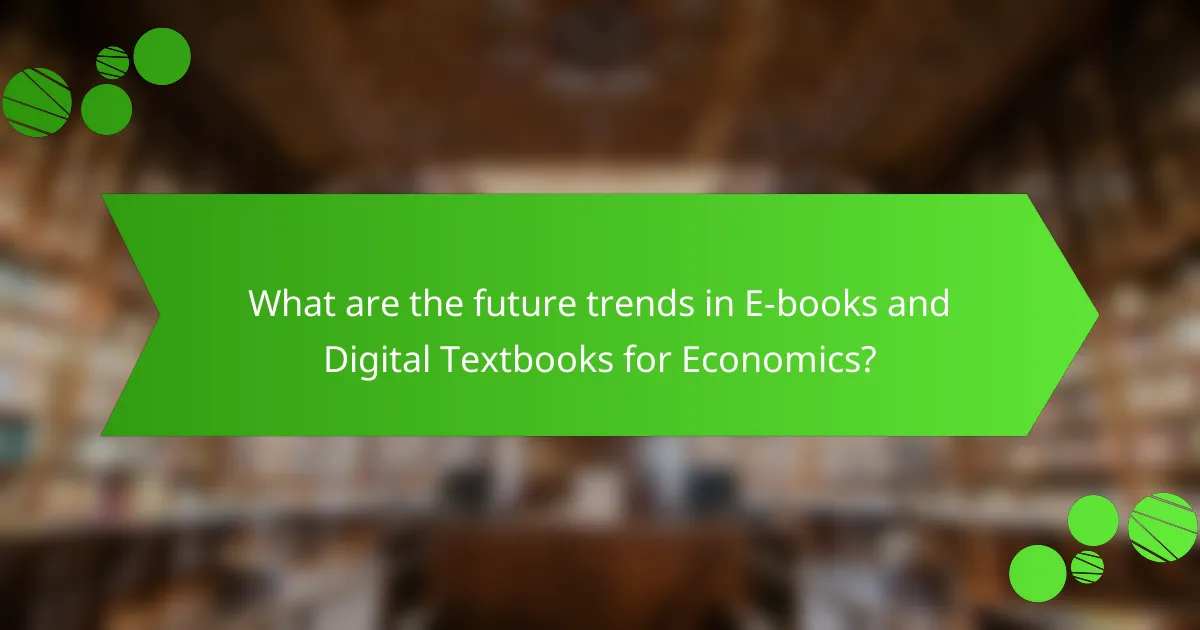
What are the future trends in E-books and Digital Textbooks for Economics?
Future trends in E-books and Digital Textbooks for Economics include increased interactivity and personalization. E-books will incorporate features like multimedia content and interactive simulations. This will enhance student engagement and comprehension. Additionally, adaptive learning technologies will tailor content to individual learning paces. Cloud-based platforms will facilitate easy access and collaboration among students and educators. The integration of AI will provide personalized recommendations based on user behavior. Furthermore, the use of blockchain technology may ensure secure and transparent transactions for digital content. These trends indicate a shift towards more dynamic and user-centered educational resources in economics.
How is technology evolving to enhance E-books and Digital Textbooks?
Technology is evolving to enhance E-books and Digital Textbooks through improved interactivity and accessibility features. Advanced formats like EPUB 3 allow multimedia integration, including audio, video, and interactive quizzes. This fosters a more engaging learning experience. Artificial Intelligence is personalizing content, adapting to individual learning styles and pacing. Machine learning algorithms analyze user behavior to recommend relevant materials. Cloud technology ensures seamless access across devices, enabling users to read anywhere and anytime. Enhanced search functionalities allow quick navigation within texts, improving information retrieval. Furthermore, accessibility tools support diverse learning needs, such as text-to-speech and adjustable font sizes. These advancements collectively contribute to a more effective educational resource.
What innovations are being integrated into E-books and Digital Textbooks?
Innovations in E-books and Digital Textbooks include interactive features, multimedia content, and adaptive learning technologies. Interactive features allow users to engage with content through quizzes and simulations. Multimedia content incorporates videos, animations, and audio to enhance understanding. Adaptive learning technologies personalize the learning experience based on individual progress and preferences. Cloud integration enables access across multiple devices seamlessly. Searchable text and annotation tools improve navigation and note-taking. Collaborative features support group work and discussions among students. These innovations enhance user engagement and learning outcomes in educational settings.
How might the role of E-books and Digital Textbooks change in education?
E-books and digital textbooks are likely to become central to educational practices. They provide interactive features that enhance learning experiences. For example, e-books can include multimedia elements like videos and quizzes. This interactivity can lead to improved engagement among students. According to a study by the National Center for Education Statistics, 82% of students reported that digital materials improved their learning. Additionally, e-books can be updated easily, ensuring that content remains current. This adaptability is crucial in fast-evolving fields like economics. Furthermore, digital textbooks often reduce costs for students compared to traditional textbooks. As technology advances, the accessibility of e-books will likely increase, reaching a broader audience. Overall, the shift towards e-books and digital textbooks is expected to transform educational methodologies significantly.
What best practices should users follow when selecting E-books and Digital Textbooks?
Users should evaluate the credibility of the source when selecting E-books and Digital Textbooks. Trusted publishers and authors enhance content reliability. Users should also check for reviews and ratings from other readers. High ratings often indicate quality content. It is important to assess the format compatibility with devices. Formats like PDF, EPUB, and MOBI should be considered based on user preference. Users should review the table of contents and sample pages. This helps gauge the content’s relevance and depth. Additionally, examining the price and availability of rental options is beneficial. Many platforms offer competitive pricing or subscription models. Finally, users should confirm the availability of updates and supplementary materials. Updated content ensures the information remains relevant and accurate.
How can students evaluate the quality of E-books and Digital Textbooks?
Students can evaluate the quality of E-books and Digital Textbooks by examining several key factors. First, they should assess the credibility of the author or publisher. Established publishers often provide reliable content. Next, students should review the content for accuracy and relevance to their course material. They can compare the E-book’s information with trusted sources.
Additionally, the usability of the E-book is important. Students should check for features like search functionality and bookmarking. These features enhance the learning experience. The formatting and layout also matter. Clear text and well-organized chapters contribute to readability.
Finally, students should consider user reviews and ratings. Feedback from peers can provide insights into the E-book’s effectiveness. Research shows that E-books with high user ratings often correlate with better learning outcomes.
What tips can enhance the reading and learning experience with E-books and Digital Textbooks?
To enhance the reading and learning experience with E-books and Digital Textbooks, utilize interactive features. These features include embedded quizzes and multimedia content. Engaging with these elements boosts retention and understanding. Adjusting font size and background color can improve readability. Studies show that personalized settings help maintain focus. Use annotation tools to highlight important information. This practice aids in reviewing key concepts later. Organizing notes within the e-textbook can streamline studying. Research indicates that structured notes enhance information recall. Lastly, take regular breaks to avoid digital fatigue. This approach supports sustained attention and comprehension.
E-books and digital textbooks for economics are electronic educational resources that provide interactive content, including theories, case studies, and data analysis. They differ from traditional textbooks by offering features such as multimedia elements, easy updates, and accessibility on various devices. Key advantages include affordability, enhanced engagement, and improved learning outcomes for students. The article also explores different formats, challenges users may face, and future trends in digital educational resources, highlighting the importance of technology in enhancing accessibility and learning experiences in economics education.

